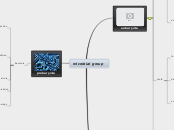Domain Bacteria
Fusobacteria
baillales
bacullus
Subtopic
disease in cattle sheep and horses that can be transmitted to humans
causes anthrax
some produce anti-biotics
only feww are pathogenic to humans
common in soil
rods that produce endospores
clostridails
epulopiscium
large enough to be seen by the unaided eye
clostridium
lives in intestinal tract
foodborne diarriha
botulinum
cause tetanus
resistance to heat and many chemicals
contains endo spores
rod-shapes
Deinocci
thermus aquaticus
Dienococcus radiodurans
Spirochaetes
leprospira
Borrelia
treponema
Purple and Green Photosynthestic Bacteria
chromatium
Chloroflexus
Fusobacterium
Nonprotepbacteria Gram- Negative Bacteris
Bacteroidetes
Cytophaga
Bacteroudes
Panctomycetes
Chlamydiae
Chylamydiae and Chlamydophila
Cyanobacteria
Probacteria
deltaproteobacteria
myxcoccus
preditor on other bacteria
move by gliding leaving a trail of slime
vegatave cells
desulfovibrio
uses sulfur rather than oxygen
Sulfu-reducing bacteria
bdellovibrio
after attatching it reproduces
attacks gram negatives
Gammaproteobacteria
Enterobacteriales
Vibrionellales
vibria
Legionellas
coxiella
legionella
pseudomonadales
acinetobacter
moraxella
azobacter and azomonas
Pseudomonas
Francisella
causes turlaremia
grows in comples media enriched with blood tissue extracts
small pleomorphic bacteria
Beggiatoa
accumulates granules of sulfur
uses hydrogen sulfade as an energy source
attatches to the surface
production of slime
mobility is by gliding
grows in aquadic sediments
Betaproteobacteria
Zoogloea
as they grow they form fluffy slimmy masses
important in sewage treatment process
Neisseria
causes gonorroea and meningitis
lives in mucus membrane of animals
bordetella
cause of whooping cough
Burkholderia
grows in disinfectant solutions
problem for people with cystic fibrosis
capable degrading 100 different organic molocules
single polar flugellum
Shaertoltius
gram negative
sewage
fresh water
Spirillum
arobic
relativly large
mainly in fresh water
Thiobacillus
involved in decomposition of organic material
important in sulfur cycle
sulfur oxidizing
epsilonproteobacteria
helicobacter
most common cause of peptic ulcers adn stomach cancer
curved rods with multipul flagellum
campylobactor
outbreaks in food born intestinal disease
can cause spontainous aborthion in domestic animals
each cell has one polar flugellum
Enterobacterials
enterobacter
lives in humans, animals, water, sewage, and soil
hospital aquired infections
can cause urinary tract infection
erwinia
causes soft rot diseases
primarly plant pathogens
yersinia
contact from respitory dropplets from infected aminal
urban rats and ground squarels carry fleas transmitt it
causes the plague
proteus
found in wombs
causese urinary tract infects
as a result the colony concentric rings
outside cells have flagella for movement and the inside have fewer
swarmers
serratia
can be found in sterile solutions
can cause urinary tract infection
distinguished by red pigment
klebsiella
can cause serious forms of pmeumonia
found in soil or water
shigella
can cause life threatning dysentery
causes bacillary dysentery or shigellosis/ only found in humans
salmonella
causes typhoid fever
identified by the letters KOH
commonly found in the intestines of animals :especially pultry and cattle.
almost all members are pathogenic
escherichia
causes urinary tract infections and traveler's diarrhea and occasionally very serious foodborne diseases
its presence in water and food indicate fecal contamination
most common inhabitants of the intestinal tract
Alphaproteobacteria
Nitrobacter and Nitrosomanas
reduce nitrogenous compounds
important to agriculture
capable of using inorganic chemicals
genra of nitrifying bacteria
brucella
important for bodies defense against bacteria
cause brucellosis
agrobacterium
causes crown gall
does not induse root nodules
invade plants
Rhizobium and Bradyhizobium
form nodules result in nitrogen fixation
known by rhizobia
specifically infect roots of beans peas and clover
Bartonella
cat-scratch disease
contains several human pathogens
Caulobactor and hyphomicrobium
produce prominent prosthecae
low-nutrient aquadic environments
use budding process to reproduce
able to anchor
found in placesd like lakes
Ehrlichia
cause ehrlichiosis
transmitted by ticks
live in white blood cells
gram-negative
Rickettsia
responsible for many diseases related to spotted fever
they are transmitted to human from bites from insects
reproduce only in mammalian cell
acetobacter and Gluconbactor
convert ethanol into acetic acid
industrially important
azospirillum
nitrogen fixation
grows in roots of plants such as tropical grasses
soil bacterium
pelagibacter
live in low nutrient enviroment
extremely small
marine Microbe
most abundant microorganisms on earth
Pateurellales
Haemophilus
causes sexually transmitted disease chancroid
septic arthritis in children, bronchitis and phneumonis
cause epiglottis
cause meningitis
require blood
inhabit mucus of upper respitory tract, mouth vagina and intestinal tract.
Pasteurella
causes sepsis in cattle fowl cholera in chickens and other fowl and pneumia









